Located in the Southeast United States, Mississippi is often celebrated as the heart of the Deep South. In addition to being known for Southern hospitality, delta blues music, riverboats, and its important role in the American Civil Rights Movement, the state is home to diverse landscapes ranging from the Delta to the Gulf Coast.
Mississippi (MS) on the US Map
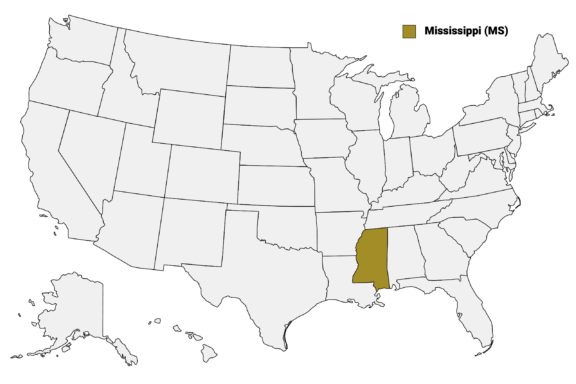
There are 82 counties in Mississippi, each with unique characteristics. From the historic antebellum homes in Natchez to the vibrant casinos of Tunica, this post will explore the most interesting counties in Mississippi. We’ll also provide a detailed Mississippi Counties Map along with information about each county.
Map of Mississippi Counties
Below is a map of the 82 counties of Mississippi (you can click on the map to enlarge it and to see the major city in each county).
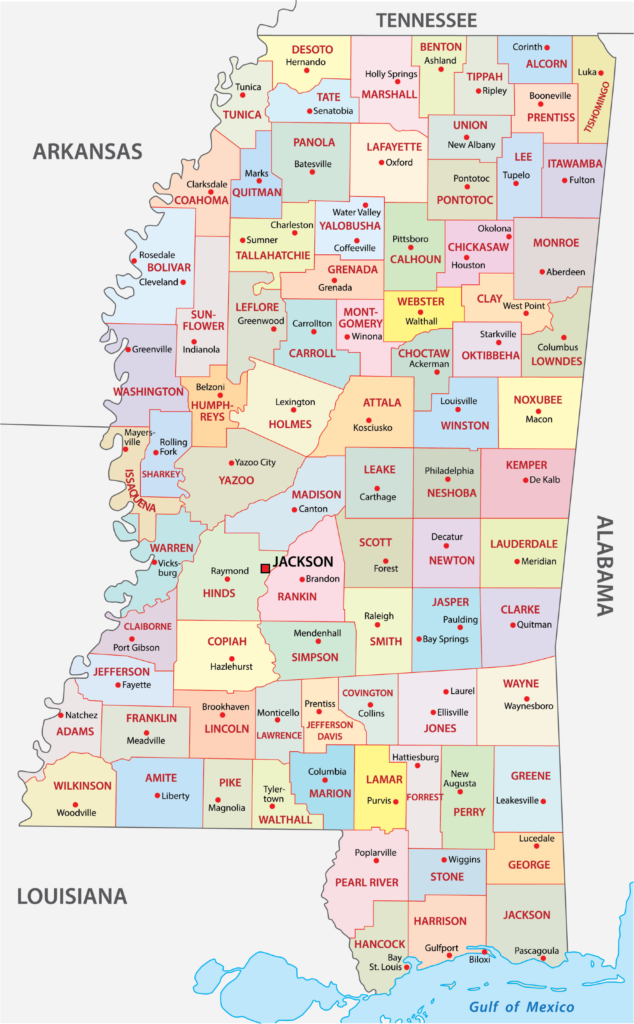
Interactive Map of Mississippi Counties
Click on any of the counties on the map to see its population, economic data, time zone, and zip code (the data will appear below the map). Data is sourced from the US Census 2021.
List of the Counties of Mississippi:
| County | Population | Per sq. km | Largest City |
|---|---|---|---|
| Adams County | 29,927 | 24.99 | Natchez |
| Alcorn County | 34,964 | 33.75 | Corinth |
| Amite County | 12,718 | 6.73 | Centreville |
| Attala County | 18,025 | 9.47 | Kosciusko |
| Benton County | 7,687 | 7.3 | Hickory Flat |
| Bolivar County | 31,301 | 13.79 | Cleveland |
| Calhoun County | 13,420 | 8.83 | Calhoun City |
| Carroll County | 10,053 | 6.18 | Vaiden |
| Chickasaw County | 17,100 | 13.16 | Houston |
| Choctaw County | 8,264 | 7.63 | Ackerman |
| Claiborne County | 9,115 | 7.22 | Port Gibson |
| Clarke County | 15,678 | 8.75 | Quitman |
| Clay County | 18,768 | 17.67 | West Point |
| Coahoma County | 21,839 | 15.25 | Clarksdale |
| Copiah County | 28,453 | 14.13 | Crystal Springs |
| Covington County | 18,491 | 17.25 | Collins |
| DeSoto County | 183,220 | 148.51 | Southaven |
| Forrest County | 77,743 | 64.41 | Hattiesburg |
| Franklin County | 7,705 | 5.28 | Bude |
| George County | 24,260 | 19.57 | Lucedale |
| Greene County | 13,653 | 7.4 | Leakesville |
| Grenada County | 21,621 | 19.78 | Grenada |
| Hancock County | 45,911 | 37.4 | Bay St. Louis |
| Harrison County | 207,382 | 139.58 | Gulfport |
| Hinds County | 230,772 | 102.43 | Jackson |
| Holmes County | 17,243 | 8.8 | Durant |
| Humphreys County | 7,916 | 7.3 | Belzoni |
| Issaquena County | 1,111 | 1.04 | Grace |
| Itawamba County | 23,863 | 17.29 | Fulton |
| Jackson County | 142,993 | 76.38 | Pascagoula |
| Jasper County | 16,406 | 9.37 | Bay Springs |
| Jefferson County | 7,286 | 5.41 | Fayette |
| Jefferson Davis County | 11,372 | 10.75 | Prentiss |
| Jones County | 67,374 | 37.44 | Laurel |
| Kemper County | 9,211 | 4.64 | De Kalb |
| Lafayette County | 55,727 | 34.06 | Oxford |
| Lamar County | 63,610 | 49.46 | Hattiesburg |
| Lauderdale County | 73,756 | 40.47 | Meridian |
| Lawrence County | 12,055 | 10.81 | Monticello |
| Leake County | 21,452 | 14.21 | Carthage |
| Lee County | 83,388 | 71.55 | Tupelo |
| Leflore County | 28,555 | 18.56 | Greenwood |
| Lincoln County | 34,910 | 22.99 | Brookhaven |
| Lowndes County | 58,904 | 45 | Columbus |
| Madison County | 108,248 | 58.51 | Jackson |
| Marion County | 24,609 | 17.52 | Columbia |
| Marshall County | 34,031 | 18.61 | Holly Springs |
| Monroe County | 34,448 | 17.38 | Amory |
| Montgomery County | 9,948 | 9.44 | Winona |
| Neshoba County | 29,153 | 19.74 | Philadelphia |
| Newton County | 21,385 | 14.29 | Newton |
| Noxubee County | 10,410 | 5.78 | Macon |
| Oktibbeha County | 51,339 | 43.26 | Starkville |
| Panola County | 33,300 | 18.76 | Batesville |
| Pearl River County | 55,972 | 26.64 | Picayune |
| Perry County | 11,611 | 6.93 | Richton |
| Pike County | 40,262 | 37.99 | McComb |
| Pontotoc County | 31,136 | 24.15 | Pontotoc |
| Prentiss County | 25,022 | 23.28 | Booneville |
| Quitman County | 6,327 | 6.03 | Marks |
| Rankin County | 156,052 | 77.69 | Jackson |
| Scott County | 28,062 | 17.78 | Forest |
| Sharkey County | 4,160 | 3.72 | Rolling Fork |
| Simpson County | 26,064 | 17.08 | Magee |
| Smith County | 14,483 | 8.79 | Taylorsville |
| Stone County | 18,356 | 15.91 | Wiggins |
| Sunflower County | 26,295 | 14.55 | Indianola |
| Tallahatchie County | 12,917 | 7.73 | Tutwiler |
| Tate County | 28,123 | 26.83 | Senatobia |
| Tippah County | 21,877 | 18.45 | Ripley |
| Tishomingo County | 18,945 | 17.24 | Iuka |
| Tunica County | 9,949 | 8.46 | Tunica Resorts |
| Union County | 27,775 | 25.8 | New Albany |
| Walthall County | 13,981 | 13.36 | Tylertown |
| Warren County | 45,141 | 29.61 | Vicksburg |
| Washington County | 45,616 | 24.33 | Greenville |
| Wayne County | 19,824 | 9.44 | Waynesboro |
| Webster County | 9,938 | 9.11 | Eupora |
| Wilkinson County | 8,706 | 4.96 | Centreville |
| Winston County | 17,846 | 11.35 | Louisville |
| Yalobusha County | 12,586 | 10.4 | Water Valley |
| Yazoo County | 27,924 | 11.69 | Yazoo City |
Largest Counties in Mississippi by Population
Hinds County
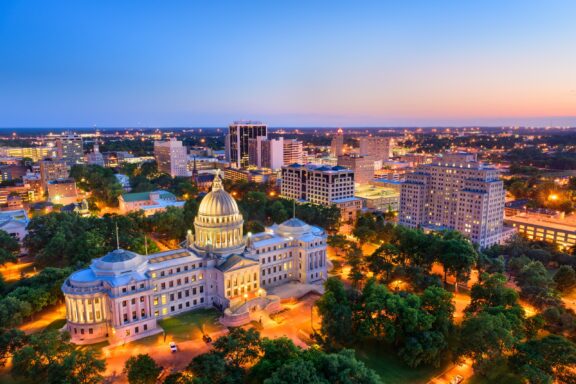
Hinds County, established in 1821, is the most populous county in Mississippi. The county is named after General Thomas Hinds, a hero of the War of 1812. Jackson, the state capital and largest city, serves as one of the two county seats, the other being Raymond.
Located in central Mississippi, Hinds County is a significant political, cultural, and economic center. Jackson is known for its rich civil rights history, with landmarks like the Mississippi Civil Rights Museum and the Medgar Evers Home Museum. The city also hosts the state government and numerous educational institutions, including Jackson State University.
The county’s landscape features a mix of urban settings and rural areas, with the Natchez Trace Parkway and the Ross Barnett Reservoir offering outdoor recreation. Hinds County plays a crucial role in Mississippi’s legal and legislative activities, and its cultural heritage contributes to the state’s identity.
Harrison County
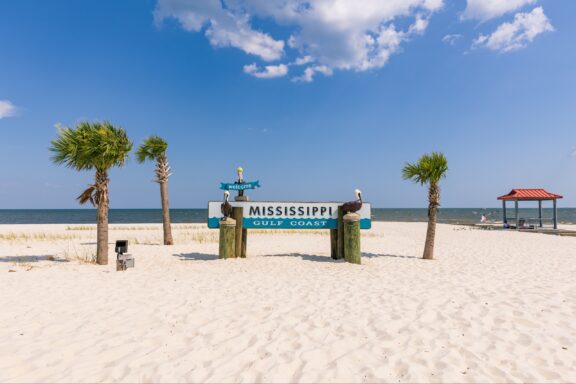
Harrison County, established in 1841, is located on the Gulf Coast of Mississippi and is the second-most populous county in the state. The county, named after U.S. President William Henry Harrison, has two county seats: Biloxi and Gulfport. Gulfport is the larger of the two and serves as a major U.S. seaport.
Harrison County is known for its vibrant tourism industry, largely due to its location along the beautiful Gulf of Mexico. The area is famous for its beaches, casinos, and the Biloxi Lighthouse, a historical landmark. The county also hosts the Mississippi Coast Coliseum and Convention Center, a hub for various events.
The region’s economy is bolstered by its maritime activities, including shipbuilding, and by the presence of Keesler Air Force Base in Biloxi. Harrison County’s blend of coastal beauty, cultural attractions, and economic significance makes it an important and dynamic part of Mississippi.
DeSoto County
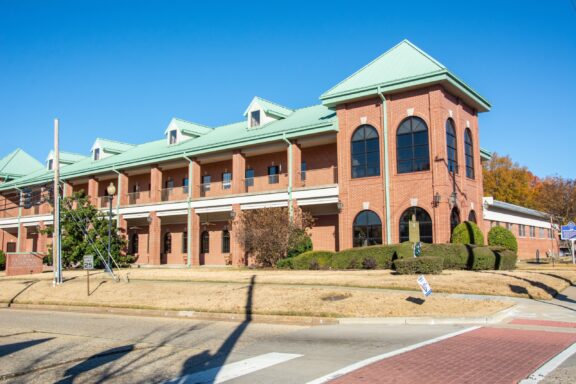
DeSoto County was organized in 1836 and is situated in the northwestern corner of Mississippi, bordering Tennessee. Named after the Spanish explorer Hernando de Soto, the county has grown rapidly and is now one of the most populous in the state. The county seat is Hernando, known for its historic antebellum homes and charming town square.
Situated just south of Memphis, Tennessee, DeSoto County is part of the Memphis metropolitan area. This proximity has contributed to its growth and development, making it a significant suburban area for those working in Memphis.
DeSoto County is characterized by its strong community focus, quality schools, and numerous parks and recreational facilities. It serves as a bridge between the urban offerings of Memphis and the agricultural heritage of northern Mississippi, reflected in annual events like the Springfest in Southaven and the A’Fair in Hernando.
Rankin County
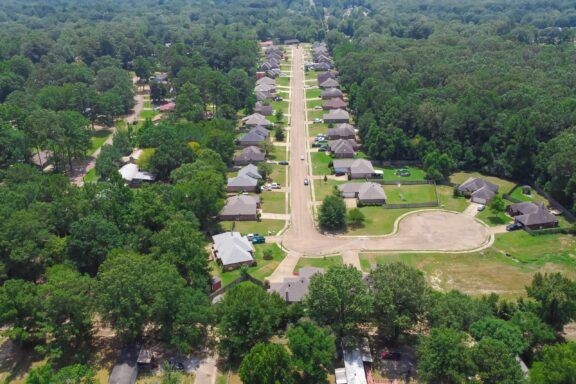
Rankin County, established in 1828, is situated to the east of the state capital, Jackson, in central Mississippi. It was named after Christopher Rankin, a Mississippi Congressman. The county seat, Brandon, is known for its welcoming small-town charm and a strong sense of community.
Rankin County has experienced significant growth due to its proximity to Jackson, making it a key suburban area for the state’s capital. This growth is complemented by a strong commitment to preserving green spaces, providing parks, and maintaining a family-friendly atmosphere.
The county’s economy is diverse, with sectors ranging from manufacturing and retail to healthcare and education. The city of Pearl is a hub for retail and entertainment in the county and is home to the Mississippi Braves minor league baseball team. Rankin County’s blend of suburban convenience, natural beauty, and community-oriented living makes it a desirable place to live in Mississippi.
Jackson County
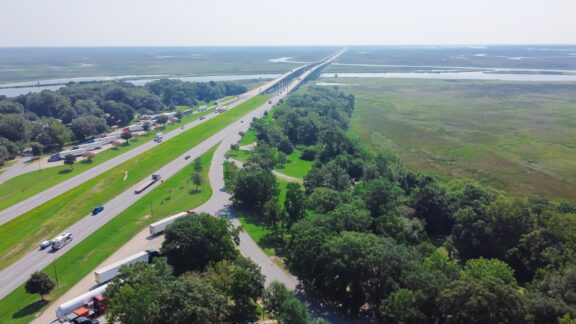
Jackson County, named after Andrew Jackson, the seventh President of the United States, is located on the Mississippi Gulf Coast. With Pascagoula as its county seat, this region is known for its strong maritime and shipbuilding industries, especially due to the presence of Ingalls Shipbuilding, the largest employer in the area.
The county’s coastal location makes it a popular destination for fishing, boating, and other water activities. It also hosts the Mississippi Deep Sea Fishing Rodeo, attracting anglers from all over. In addition to its vibrant marine life, Jackson County is home to the Gulf Islands National Seashore, offering pristine beaches and unspoiled natural habitats.
Culturally, the county celebrates its heritage through various festivals and the Mardi Gras season, reflecting the Gulf Coast’s rich traditions. The Walter Anderson Museum of Art in Ocean Springs further enriches the county’s cultural landscape.
Smallest Counties in Mississippi by Population
Issaquena County
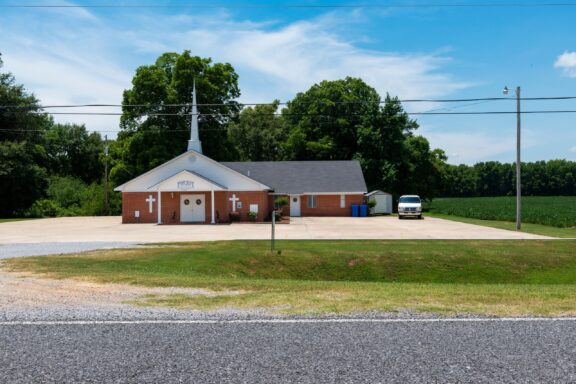
In the heart of the Mississippi Delta lies Issaquena County, notable for being the least populous county in Mississippi and one of the least populous in the United States. The county’s name originates from a Choctaw word meaning “deer river.” Mayersville, a small town embodying the deep rural character of the Delta, serves as the county seat.
Issaquena County has a rich history tied to the cotton plantation economy and is known for its significant role during the Civil War and the Civil Rights Movement. The county’s landscape, dominated by the Mississippi River and fertile agricultural land, reflects its past as a major cotton-producing area.
Today, Issaquena County is known for its untouched natural beauty and abundant wildlife, making it a haven for hunting and fishing enthusiasts. The county’s remote location and small population contribute to its quiet, laid-back lifestyle, offering a contrast to the more urbanized areas of Mississippi.
Sharkey County
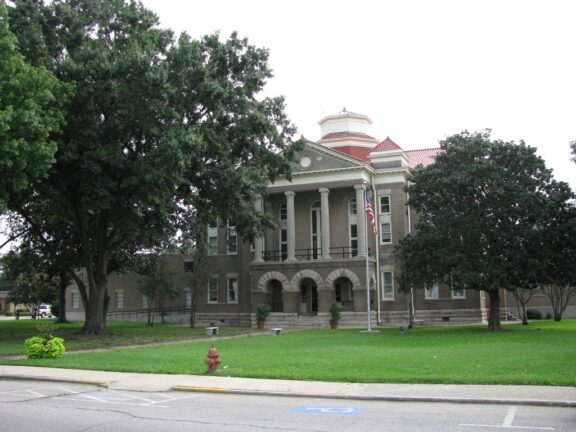
Sharkey County, established in 1876, is nestled in the heart of the Mississippi Delta. Named after William L. Sharkey, a provisional Governor of Mississippi during the Civil War, the county is steeped in Southern history and culture. The county seat, Rolling Fork, is a quintessential Delta town, known for its rich agricultural heritage.
This county is part of the fertile Yazoo-Mississippi Delta region, making agriculture a significant part of its economy, particularly in the cultivation of cotton, soybeans, and corn. Sharkey County is also recognized for its contribution to blues music, with the Delta’s deep musical roots influencing many legendary blues artists.
The county’s natural landscape includes part of the Delta National Forest, the only bottomland hardwood forest in the National Forest system, offering unique wildlife viewing and hunting opportunities.
Quitman County
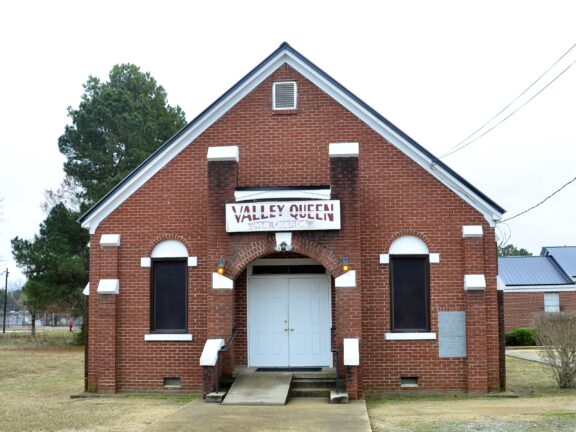
Quitman County, named in honor of John A. Quitman, a former Governor of Mississippi and prominent figure in the Mexican-American War, was established in 1877. Located in the northwest part of Mississippi, it is part of the historic and culturally rich Mississippi Delta region.
The county seat, Marks, gained national attention in 1968 as the starting point of the Poor People’s Campaign’s Mule Train to Washington D.C., a significant event in the Civil Rights Movement.
The county’s economy has historically been rooted in agriculture, with cotton farming playing a central role. However, like many parts of the Delta, Quitman County has faced economic challenges and shifts, leading to efforts to diversify its economic base.
Quitman County is characterized by its flat deltaic plains, offering a glimpse into the rural and agricultural landscape of the Deep South.
Notable Counties in Mississippi
Lafayette County
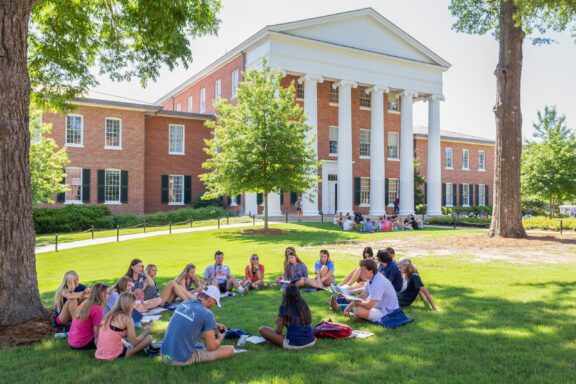
Lafayette County, in the rolling hills of North Mississippi and established in 1836, is renowned for its blend of educational prestige and rich cultural heritage. Oxford, the county seat, is famously home to the University of Mississippi, affectionately known as Ole Miss, a significant pillar in the state’s educational landscape.
This county has a special place in the literary world as the residence of William Faulkner, one of America’s most celebrated authors. His home, Rowan Oak, now a museum, draws literary enthusiasts from across the globe. Oxford’s vibrant town square, characterized by historic architecture, local boutiques, and renowned restaurants, serves as a cultural and social hub.
Beyond its literary and academic accolades, Lafayette County offers scenic beauty with its wooded landscapes and rolling hills. The county’s unique blend of Southern history, academic excellence, and cultural richness makes it a standout destination in Mississippi, embodying a blend of traditional charm and intellectual vigor.
Neshoba County
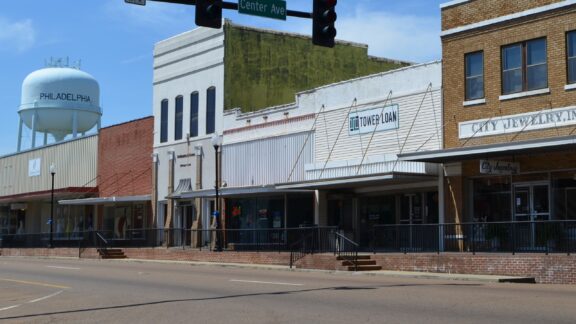
Neshoba County, established in 1833, is steeped in history and tradition. Located in the heart of Mississippi, it is perhaps best known for hosting the Neshoba County Fair, often referred to as Mississippi’s Giant Houseparty. This event, held annually since the late 19th century, is a unique blend of political rally, family reunion, and cultural festival, attracting thousands of visitors.
The county gained national attention during the civil rights era, particularly for the tragic events of 1964, known as the “Mississippi Burning” murders. This dark chapter in the county’s history was a crucial moment in the Civil Rights Movement, bringing widespread attention to the struggle for racial equality in the South.
Philadelphia, the county seat, is a hub for the region’s economic and social activities. In recent years, the county has seen economic growth and diversification, partly due to the presence of the Pearl River Resort, a major casino and resort complex owned and operated by the Mississippi Band of Choctaw Indians.
Lowndes County
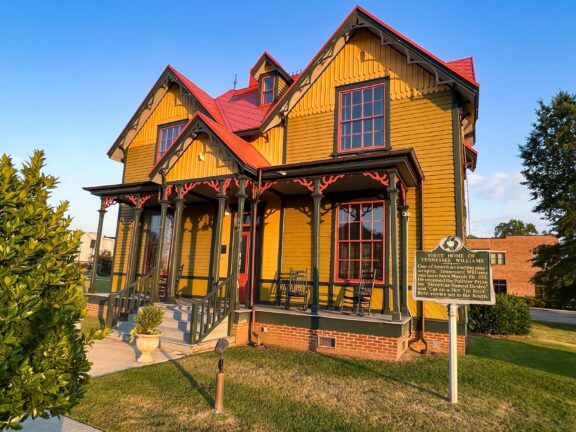
Lowndes County, named after U.S. Congressman William Lowndes, was established in 1830 in eastern Mississippi. The county seat, Columbus, is a city steeped in history, often celebrated for its beautiful antebellum homes and as the birthplace of Tennessee Williams, one of America’s most influential playwrights.
Columbus hosts the annual Spring Pilgrimage, a tour of historic homes and gardens that showcases the region’s rich architectural and cultural history. The city’s historic downtown, with its vibrant shops and restaurants, reflects the blend of Southern charm and economic vitality.
The county’s location on the Tombigbee River has historically been a driver of its economy, particularly in manufacturing and commerce. Lowndes County has evolved into a regional industrial hub, with the Golden Triangle Regional Airport and the Columbus Air Force Base contributing significantly to its development and employment.
Adams County
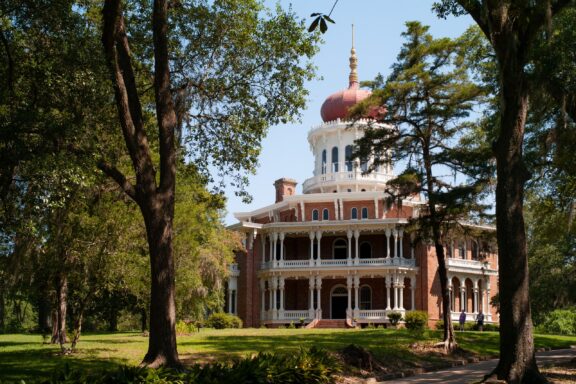
Adams County, with its rich historical tapestry, was one of the original counties of Mississippi, established in 1799. Natchez, the county seat, is distinguished as the oldest European settlement on the Mississippi River and is a treasure trove of antebellum history.
Natchez is renowned for its Spring and Fall Pilgrimages, where splendid antebellum homes open their doors to visitors, showcasing their opulent architecture and storied pasts. The city’s Natchez Trace Parkway, a scenic road following an ancient Native American trail, offers a journey through early American history and natural beauty.
Adams County’s location along the Mississippi River played a significant role in its development, particularly in the cotton trade. Today, its economy is bolstered by tourism, attracted by the county’s historical significance and the charm of Natchez, with its well-preserved historical district, vibrant cultural scene, and stunning river views.
Tunica County
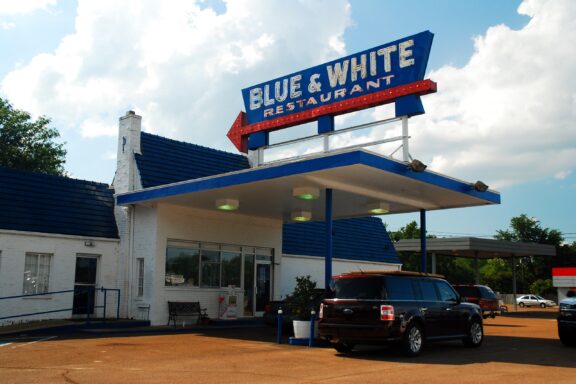
Tunica County, located in the northwest part of Mississippi, has experienced a remarkable transformation in recent decades. Once known as one of the poorest areas in the United States, the county underwent an economic revival with the legalization of gambling in the early 1990s. This shift led to Tunica being dubbed “The South’s Casino Capital.”
The county seat, Tunica, is part of the Memphis, Tennessee, metropolitan area and has capitalized on its proximity to Memphis to attract visitors. The introduction of casinos, entertainment complexes, and resorts transformed the local economy, creating jobs and increasing tourism.
In addition to its gaming and entertainment industries, Tunica County retains its agricultural roots, with the fertile Delta land continuing to support cotton, soybeans, and other crops. The Tunica RiverPark & Museum provides insight into the natural and cultural history of the Mississippi Delta.
More About Mississippi Counties: FAQs
Which Mississippi county is known for its pottery and art?
Lee County, especially the city of Tupelo, is known for its vibrant arts scene, including pottery, owing to local clay resources and artistic communities.
What is the largest county in Mississippi by land area?
Yazoo County is the largest by land area in Mississippi, covering 920 sq mi (2,383 km2).
Which county in Mississippi has the lowest cost of living?
Quitman County often ranks as one of the counties with the lowest cost of living in Mississippi.
What were the first counties in Mississippi?
The first counties in Mississippi, formed in 1799, were Adams, Jefferson, and Wilkinson counties.
What is the most beautiful county in Mississippi?
While “most beautiful” is subjective, many consider Lafayette County, with its rolling hills and historic Oxford charm, as particularly picturesque.
Image Sources and Copyright Information
- Twilight Over Jackson, Mississippi Skyline with View of the State Capitol Building: © Sean Pavone/Shutterstock
- Exterior View of a Modern Brick Courthouse Building on a Sunny Day: © Nina Alizada/Shutterstock
- Aerial View of a Quiet Residential Cul-de-sac with Lush Greenery: © Trong Nguyen/Shutterstock
- Aerial View of a Highway Rest Area with Parking and Surrounding Green Wetlands: © Trong Nguyen/Shutterstock
- Small Rural Church with Blue Sky in Mayersville, Mississippi: © TLF Images/Shutterstock
- Sharkey County Courthouse in Mississippi on a Cloudy Day: © Natalie Maynor/Wikimedia Commons | CC BY 2.0 Generic
- Valley Queen Missionary Baptist Church in Marks, Mississippi: © Magnolia677/Wikimedia Commons | CC BY 4.0 International
- Students Gathered for an Outdoor Class on a Sunny Day at a University Campus: © Ken Wolter/Shutterstock
- Street View of Courthouse Square in Philadelphia, Mississippi with Local Shops and Water Tower: © James Case/Wikimedia Commons | CC BY 2.0 Generic
- Victorian-Style Birthplace House with Historical Marker in Lowndes County, Columbus MS: © Chad Robertson Media/Shutterstock
- Historic Mansion Surrounded by Lush Greenery in Natchez, Mississippi: © Dietmar Rauscher/Shutterstock
- Blue and White Restaurant Exterior on a Sunny Day: © James Kirkikis/Shutterstock